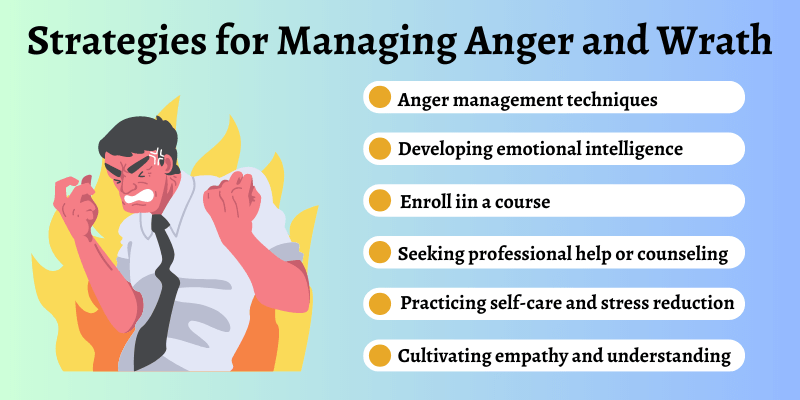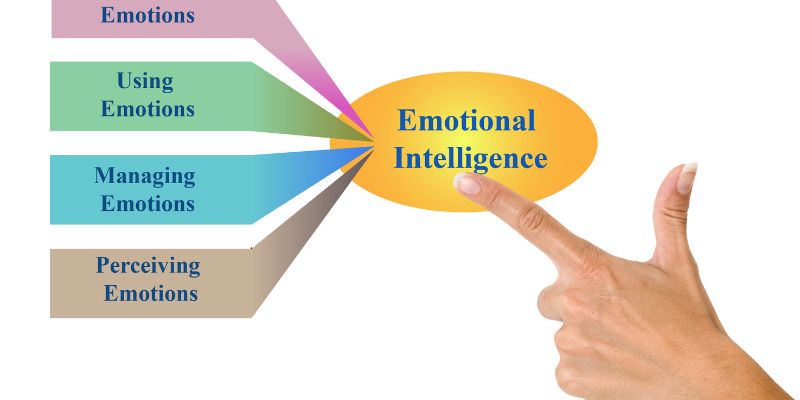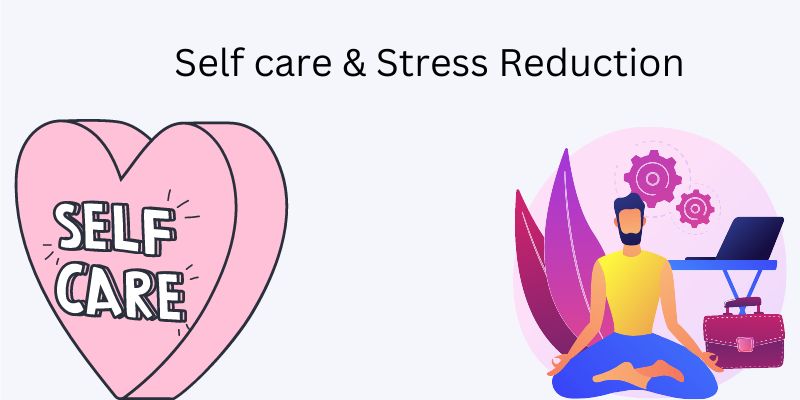
Difference Between Anger and Wrath: Explained
Understanding the difference between anger and wrath is crucial for effectively managing our emotions and maintaining healthy relationships. While both emotions involve intense displeasure, they have distinct characteristics and implications.
Anger is a natural response to frustration, provocation, or boundary violations. It is a temporary emotion ranging from mild irritation to intense fury. Anger signals that something is wrong and can motivate us to take constructive action or address the source of our frustration.
In contrast, wrath goes beyond ordinary anger. It is a more intense and prolonged form of anger fueled by a strong desire for revenge or harm toward others.
Wrath often stems from deep-seated resentment, moral indignation, and a craving for retribution. Unlike anger, which tends to dissipate over time, wrath can linger and lead to destructive thoughts and behaviors.
Recognizing the differences between anger and wrath is essential for several reasons. By understanding the distinctions, we can actively work towards managing our anger in healthier ways, prioritizing our emotional well-being.
Understanding the differences helps us make more ethical choices in challenging situations. It allows us to assess whether our anger is justified and whether seeking revenge aligns with our values and principles.
This awareness guides us towards more compassionate and fair actions, promoting positive change without causing harm.
What is Anger?
Anger is an intense emotion that is characterized by feelings of displeasure, irritation, or hostility. It is a natural and normal human response to various situations, such as perceived threats, frustrations, injustices, or when our boundaries are violated.
Anger can manifest in different ways, ranging from mild annoyance to intense rage. A range of psychological and physiological responses accompanies it.
Psychologically, anger can increase arousal, heightened vigilance, and a sense of urgency. Physiologically, it can increase heart rate, elevate blood pressure, muscle tension, and release stress hormones.
When experiencing anger, individuals may exhibit a range of expressions and behaviors. These can include verbal expressions such as shouting, swearing, or sarcastic remarks.
Physical manifestations can involve clenched fists, aggressive posturing, or physical violence. People may also display nonverbal cues like facial expressions, body language, and tone of voice indicating anger.
It’s important to note that while anger is a normal emotion, expressing it in a destructive or harmful manner can negatively affect oneself and others.
Uncontrolled or excessive anger can lead to various potential consequences. In relationships, it can strain communication, create conflicts, and damage trust and intimacy.
Chronic anger can harm physical and mental health, contributing to high blood pressure, cardiovascular problems, chronic stress, and mental health disorders such as depression or anxiety.
Additionally, uncontrolled anger can result in legal problems, damage professional relationships, and negatively impact the overall quality of life.
What is Wrath?
Wrath is an intense and prolonged form of anger characterized by a deep desire for revenge or inflicting harm on others. It goes beyond ordinary anger in intensity and duration, often fueled by resentment and a sense of moral indignation.
While anger is a temporary emotion that can motivate constructive action, wrath lingers, leading to destructive thoughts and behaviors.
Wrath has been referenced in various religious texts, including the Bible, and its cultural interpretations and symbolism are attached to it.
In human relationships and society, unchecked wrath can have detrimental effects, causing harm to individuals and perpetuating cycles of conflict and violence.
Understanding the nature of wrath is essential for managing and transforming it into healthier forms of anger, fostering empathy, and promoting a more peaceful and compassionate world.
Key Differences between Anger and Wrath
To better understand the nuances between anger and wrath, let’s explore the key differences in intensity, duration, underlying emotions, outward behavior, and impacts on individuals and relationships.
| Factors | Anger | Wrath |
| Level of Intensity | Can range from mild to intense | Intense and heightened, often consuming |
| Duration and Lingering Effects | Temporary, typically subsides once the triggering factor is resolved or managed effectively | Prolonged, lingers and festers, can become a recurring pattern |
| Motivations and Underlying Emotions | Frustration, perceived threats, violations of boundaries, feeling provoked | Deep-seated resentment, moral indignation, desire for revenge |
| Expression and Outward Behavior | Assertive communication, setting boundaries, expressing frustration constructively | Aggressive and violent outbursts, desire to punish or cause harm |
| Impacts on Individuals and Relationships | Can be constructive if managed well, promotes change and problem-solving | Destructive, strains relationships, leads to harm, conflicts, and damage |
| Physical Manifestations | Increased heart rate, elevated blood pressure, muscle tension | Heightened physiological responses, potential for physical violence |
| Cognitive Effects | Heightened alertness, increased focus on the issue at hand | Obsessive thoughts, difficulty letting go, desire for vengeance |
| Potential Triggers | Perceived unfair treatment, disrespect, frustration, injustice | Betrayal, severe wrongdoing, moral transgressions, personal attacks |
| Repercussions on Mental Health | Can lead to stress, anxiety, or depression if unmanaged | May contribute to chronic anger, bitterness, and hostile worldview |
| Role in Relationships | Can be an opportunity for growth, better communication, conflict resolution | Damages trust, strains communication, fosters resentment and conflict |
| Path to Resolution | Active management through coping strategies, problem-solving, seeking support | Requires deep introspection, forgiveness, and transformational work |
Similarities between Anger and Wrath
While anger and wrath may seem distinct, they also share commonalities regarding emotional and physiological responses, potentially harmful effects on health, and their connection to the human experience and decision-making process.
Let’s examine the similarities between these intense emotions.
| Aspect | Anger | Wrath |
| Common Emotional and Physiological Responses | Increased heart rate, elevated blood pressure, muscle tension | Similar physiological responses, heightened arousal, increased adrenaline |
| Potential Negative Effects on Physical and Mental Health | Can contribute to stress, anxiety, or depression if unmanaged | Similar potential for negative impact on physical and mental well-being |
| Connection to the Human Experience and Emotional Expression | Natural human emotion, part of the range of human experiences | Both are intense emotions experienced by individuals |
| Influence on Decision-Making and Actions | Can influence impulsive decision-making and aggressive behaviors | Similar potential for impulsive and aggressive actions if uncontrolled |
Strategies for Managing Anger and Wrath

Intense emotions like anger and wrath can be challenging to manage, but there are effective strategies that can help. Some of these strategies include:
- Anger management techniques
- Developing emotional intelligence
- Enroll In a course
- Seeking professional help or counseling
- Practicing self-care and stress reduction
- Cultivating empathy and understanding
By incorporating these strategies into your life, you can better control your anger, promote healthier responses, and enhance your overall well-being and relationships.
Explore the following strategies to learn practical techniques, develop emotional intelligence, and foster a more balanced and peaceful approach to handling anger and wrath.
Anger Management Techniques

Anger management techniques involve learning and practicing specific coping strategies and regulating anger effectively. These techniques include deep breathing exercises, progressive muscle relaxation, and mindfulness practices.
Deep breathing helps to calm the body and mind, while progressive muscle relaxation helps release tension.
Mindfulness involves being present at the moment, observing and accepting your emotions without judgment. These techniques can help interrupt the anger response, allowing you to respond to situations more calmly and thoughtfully.
Developing Emotional Intelligence

Emotional intelligence refers to recognizing, understanding, and managing emotions effectively. Developing emotional intelligence involves increasing self-awareness of your emotions, triggers, and response patterns.
It also includes learning to regulate emotions by employing strategies such as reframing thoughts, challenging assumptions, and choosing alternative perspectives.
By improving emotional intelligence, you can gain better control over anger and wrath, making navigating conflicts easier and communicating more effectively with others.
Enroll in a Course

Enrolling in an anger management course or workshop can provide structured guidance and support in managing anger and wrath.
These programs offer education on anger triggers, communication skills, and conflict resolution techniques. They may also teach coping mechanisms and provide a safe space to share experiences and learn from others.
Mastering Anger offers some of the most comprehensive anger management programs that can help you identify your anger trigger and effectively control anger symptoms. Considering the severity of your anger issues, you can enroll in the following classes:
Anger Management courses offered by Mastering Anger are nationally recognized and meet the requirements of courts, probation, legal systems, parole, and employers.
By enrolling in such a course, you actively self-improve and acquire tools and knowledge to better manage and control your anger, leading to healthier relationships and increased emotional well-being.
Seeking Professional Help or Counseling

In some cases, seeking professional help or counseling from a therapist or counselor specializing in anger management can be beneficial. A professional can help you explore the underlying causes of anger and wrath, identify any potential mental health issues, and provide personalized guidance.
They may use various therapeutic approaches, such as cognitive-behavioral therapy (CBT) or anger management interventions, to help you develop coping strategies, improve self-awareness, and modify behavior patterns.
Professional guidance can provide valuable support and tools for managing anger and promoting healthier emotional responses.
Practicing Self-Care and Stress Reduction

Engaging in self-care activities and stress reduction techniques is crucial for managing anger and wrath. This includes maintaining a healthy lifestyle with regular exercise, adequate sleep, and a balanced diet.
Additionally, practicing stress reduction techniques such as meditation, yoga or engaging in hobbies and activities that bring joy and relaxation can help reduce overall stress levels.
Taking care of yourself physically and mentally enhances emotional resilience, making it easier to handle anger triggers and respond more composedly.
Cultivating Empathy and Understanding

Cultivating empathy involves putting yourself in someone else’s shoes and seeking to understand their perspectives and experiences. By practicing empathy, you can better understand others’ emotions, motivations, and needs, which can help diffuse anger and wrath.
Cultivating empathy also involves active listening, open-mindedness, and acknowledging the complexity of situations.
By fostering empathy and understanding, you can promote healthier communication, build stronger relationships, and respond to conflicts with compassion and empathy.
Incorporating these strategies into your life allows you to develop effective tools and approaches for managing anger and wrath. Each strategy contributes to self-awareness, emotional regulation, and healthier responses, ultimately promoting personal growth, improved relationships, and a more positive and harmonious life.
Conclusion
It is crucial to understand the difference between anger and wrath to utilize the best anger management strategies.
While anger is a natural emotion that can motivate change and communication, wrath goes beyond normal anger, often fueled by resentment and a desire for revenge.
Recognizing the differences between these intense emotions allows us to respond more constructively and avoid the harmful consequences of uncontrolled anger or wrath.
Managing anger and wrath is crucial for our well-being and the well-being of those around us. By developing self-awareness, practicing emotional regulation techniques, and seeking professional help if needed, we can learn to express and manage our emotions in healthier ways.
This includes finding healthy outlets for emotional expression, engaging in effective conflict resolution, and cultivating empathy and understanding in our interactions.
It is essential to encourage and support one another in seeking healthy ways of emotional expression and conflict resolution.
We can promote understanding, resolve conflicts peacefully, and build stronger relationships by fostering open and respectful communication. Let us strive to create a world where anger issues are transformed into opportunities for growth, compassion, and positive change.






Responses